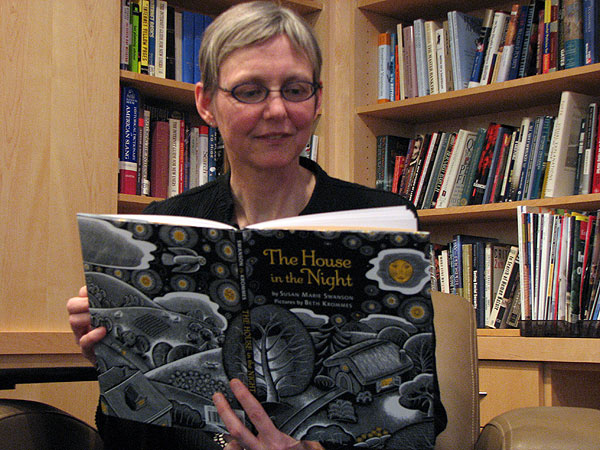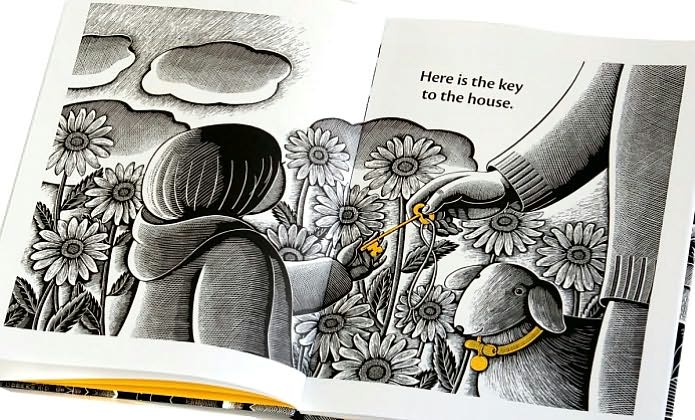The House in the Night
By: Susan Marie Swanson
Pictures by: Beth Krommes
Published by: Houghton Mifflin Books 2008
By: Susan Marie Swanson
Pictures by: Beth Krommes
Published by: Houghton Mifflin Books 2008
Grade Levels: Pre-K-Grade 1
Genre: Picture Book, Bedtime Story
Caldecott Medal Winner in 2009
Genre: Picture Book, Bedtime Story
Caldecott Medal Winner in 2009
Synopsis: The House in the Night, is a book that was inspired by The Oxford Nursery Rhyme Book, which was first published in 1955 by Iona and Peter Opie. Susan Marie Swanson was inspired by one nursery rhyme in particular which started “This is the key of the kingdom.”It uses a scratchboard technique of black and white illustrations that makes the story come alive in texture. On each page it illuminates different aspects or items the story is talking about with golden accents. The book uses a cumulative pattern throughout the text which explores the origin of light that makes a house a home. This book takes you through different things in a house at night, starting with a little girl holding the key to the house. She goes on to explore a room in the house where she sees a bed, that rests a book, and in that book is a bird that comes to life and flies her around the night where she sees the moon. It then takes the girl back through each thing she sees and ends with her in her bed with the key to the house in the night.
Themes/Skills: Darkness/Light, The World, The Order of the Universe. It deals with patterns and sequence. It uses the skill of black and white Scratchboard Technique that illuminates different items on each page that it talks about. It can deal with Phonemic Awareness, Comprehension, and Word Recognition.
Themes/Skills: Darkness/Light, The World, The Order of the Universe. It deals with patterns and sequence. It uses the skill of black and white Scratchboard Technique that illuminates different items on each page that it talks about. It can deal with Phonemic Awareness, Comprehension, and Word Recognition.
About the Author: Susan Marie Swanson
 Susan Marie Swanson was born on May 19th and grew up near Chicago, Illinois. As a little girl, she loved visiting her public library and the bookstore. When she was ten years old, her first poem about snowflakes was published in the town newspaper. Susan attended and received a Master of Fine Arts Degree in English from the University of Massachusetts at Amherst. Susan is known by many as a poet and picture book author. Her first book ever published was Getting Used to the Dark, a book of poetry about the night, in 1997. She is also known for writing the books, Letters to the Lake, The First Thing My Mama Told Me, To be like the Sun, and The House in the Night. The House in the Night received the Caldecott Medal along with many other prestigious reviews and awards in 2009. Not only is she an author of children’s books, she is also a highly respected reviewer of children’s books as well. Besides writing and reviewing, Susan Marie has helped children write poetry at the COMPAS Writers and Artists in the Schools Program and at St. Paul Academy and the Friends School of Minnesota summer arts program for more than 25 years. Susan Marie currently lives with her family in St. Paul, Minnesota.
Susan Marie Swanson was born on May 19th and grew up near Chicago, Illinois. As a little girl, she loved visiting her public library and the bookstore. When she was ten years old, her first poem about snowflakes was published in the town newspaper. Susan attended and received a Master of Fine Arts Degree in English from the University of Massachusetts at Amherst. Susan is known by many as a poet and picture book author. Her first book ever published was Getting Used to the Dark, a book of poetry about the night, in 1997. She is also known for writing the books, Letters to the Lake, The First Thing My Mama Told Me, To be like the Sun, and The House in the Night. The House in the Night received the Caldecott Medal along with many other prestigious reviews and awards in 2009. Not only is she an author of children’s books, she is also a highly respected reviewer of children’s books as well. Besides writing and reviewing, Susan Marie has helped children write poetry at the COMPAS Writers and Artists in the Schools Program and at St. Paul Academy and the Friends School of Minnesota summer arts program for more than 25 years. Susan Marie currently lives with her family in St. Paul, Minnesota. About the Illustrator: Beth Krommes
“My mission is to create artwork that is joyful in spirit, universal in nature, and accessible and affordable to others.”-Beth Krommes
Beth Krommes grew up in Emmaus, Pennsylvania. She attended Syracuse University where she received a BFA degree in painting. She also received a MAT in Art Education from the University of Massachusetts. Beth was an art teacher in a public school, a manager in a handcraft shop, and an art director of a computer magazine before devoting her time fully to illustrating children’s books in 1989. Beth uses both wood engraving and scratchboard in her illustrations. In 1999 Beth published her first children’s book, Grandmother Winter. She also illustrated for books including The Lamp, the Ice, and the Boat Called Fish, The Sun in Me-Poems About the Planets, Hidden Folk, Butterfly Eyes and Other Secrets of the Meadow, The House in the Night, and her most recent, Swirl by Swirl: Spirals in Nature, in 2011. In 2009, her illustrations in the book, The House in the Night, won the Caldecott Medal. Beth currently lives in New Hampshire with her husband and two daughters.
Source used: http://www.bethkrommes.com/biography
Source used: http://www.bethkrommes.com/biography
Pre-Reading Activities: Use Anticipation Guide for Readers. Turn off the lights and put the picture of the cover on the overhead. Have children first look at the picture and think about what they see during the night. Ask them questions such as: What comes to mind when you think of night time? What is usually lit up at night? What do you see in the sky at night? What do you see lit up i your house at night? Give students a few minutes to come up with ideas. Then create a chart of their ideas that they come up with and review them as you write them down. While you are writing these ideas down, sound out the letters that you write to show students the sounds that the letters make in each word.
Post-Reading Activities: The purpose of this post-reading activity is to help children learn vocabulary words by using pictures and phonemic awareness to identify words. Since they will have already heard the book once, they will be somewhat familiar with the objects in each page and the cumulative sequence of the poem. Teachers will take each page from the book and blow them up to place on the board. Then on each page take the sentence and post it underneath the picture on the board. Each sentence underneath will have the word of the yellow illuminated object missing from it. These words will be placed on the side of the board for children to choose from. Children will take turns coming up to the board to find the word to fit in the sentence. They will sound out the sentence first underneath the picture and identify the missing word. Then they will choose from words on the side the one that is correct by sounding out each letter in the word. The other children will be the judges and put a thumbs up if it is correct or a thumbs down if it is incorrect.
Example
Here is the _____________ to the house.
Choices:
girl
dog
key
door
Choices:
girl
dog
key
door
Reflection: I like the use of the scratchboard technique throughout the entire book. Illuminating one or two items on each page allows small children to grasp the story better and focus on that object. It allows them to recognize the word in the book to the pictures. Although some may say that black and white illustrations create a sense of gloominess, I think that this allows reader to focus on the important elements that stand out in yellow. I love the rhythm of the book and the way that each page leads into the next in some way. This is great for small children to learn sequencing and ability to grasp words with pictures and their meaning.



No comments:
Post a Comment